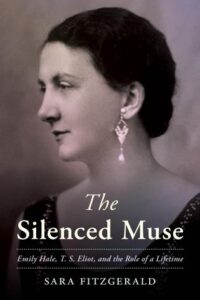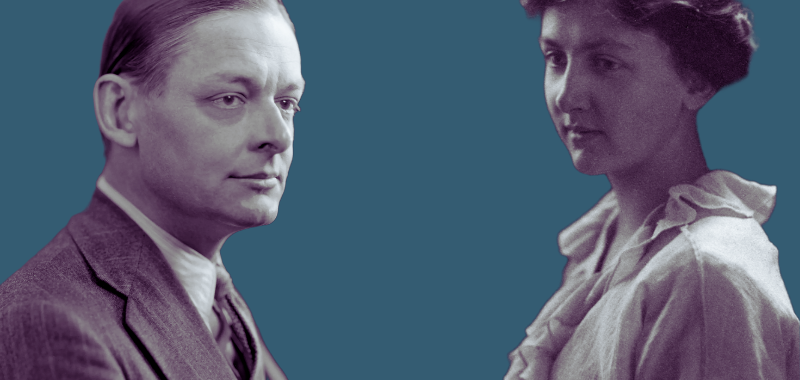It was at his cousin Eleanor’s home in Cambridge, Tom recalled. A small party, an impromptu game of charades. He stepped on Emily Hale’s feet—and promptly fell in love with her.
Article continues after advertisement
For decades, their story was hidden away, a matter of scholarly speculation. A few months before Eliot married his secretary, Hale donated the 1,131 letters he had sent her to the Princeton Library, a plan they had discussed for many years. The letters would be sealed until fifty years after both of them died.
They had met as teenagers in 1905, the year Eliot arrived in Boston to attend Milton Academy before going on to Harvard. They were both born outside New England, but to families that were well established there. Eliot came from St. Louis, where his grandfather had founded Washington University and his father owned a brick-making company. When summer came, his family escaped to the Massachusetts coast, where he played with his cousins, Eleanor, Barbara, and Frederick.
While Hale’s story remained sealed for another thirty-two years, her reputation was defined by those who could speak.
Since their schooldays in Cambridge, Eleanor Hinkley had been good friends with Emily Hale. Hale was three years younger than Eliot, born in East Orange, New Jersey, where her father had been called to start a Unitarian church. But when she was five, Edward Hale was lured back to Boston to teach at Harvard Divinity School and lead a growing congregation in Chestnut Hill.
Emily was an only child and Tom was treated like one, because he was eight years younger than his closest sibling. He was shy, and spent his days dreaming and reading books. “I never talked,” he recalled, “for who was there to talk to?”
*
At twenty-four, Eliot returned to Harvard after a year in Europe to complete a doctorate in philosophy. Hale was pursuing a life as an amateur actress. And Eleanor Hinkley dreamed of becoming a playwright.
Hinkley decided to organize a “Stunt Show” in her Cambridge home on the night of February 17, 1913. She drafted Hale, her Eliot cousins, and other Harvard and Radcliffe friends to perform in her skits. Tom played opposite Emily in a sketch based on Jane Austen’s Emma. When their rehearsals began, he started “to realise what had happened” to him.
Their audience would have included friends and relatives, but Emily’s mother, Emily Jose Milliken Hale, wasn’t present. In 1897, shortly after the Hales returned to Boston, her son, William, died of dysentery a few days before his second birthday. After the tragedy, Mrs. Hale had a breakdown—and disappeared from her family’s life. For her remaining years, she would be confined to McLean Hospital in Belmont, already a go-to place for the psychiatric treatment of the East Coast elite.
Emily left no words describing how it felt to be “abandoned” by her mother when she was only five. But the childhood trauma undoubtedly fueled a life-long desire to be “a good girl,” a woman who tried to please others so she would never be rejected again.
The loss may have also sparked Hale’s love for the stage. Plays allowed Hale to try on new roles, to step into a world of make-believe. The comedies she favored had happier endings than the chapters of her own life. And theater companies, casts, and school drama clubs all provided a substitute for the tight-knit family she would never truly know.
In Boston, theater was something well-connected people did. Performing for a charity made it even more acceptable. And the Stunt Show was no exception.
It was pitched as a benefit for Cambridge Visiting Housekeeping, which promoted domestic work for young women to keep them off the streets. Hale had taken voice lessons for seven years, and Hinkley put her talents to good use: she kicked off both acts by singing three romantic songs from the Gay Nineties. Afterward, the Cambridge Chronicle reported that Emily’s performance for the forty guests “was a favorite.”
For “An Afternoon with Mr. Woodhouse,” Hinkley played Emma and, in a stroke of casting genius, she recruited Eliot to play Emma’s hypochondriac father. Years later, Hale recalled that she was “a natural” to play the fussy Mrs. Elton and that Eliot had played Mr. Woodhouse “very delightfully.”
The rehearsals may have deepened Eliot’s attraction to Hale, but she did not reciprocate his feelings, if she was even aware of them. She admired Eliot’s intelligence, but he was still painfully shy around women. Among her circle, no one was in a rush to get married. Harvard men, meanwhile, were said to categorize women according to their debutante status: pre-deb, deb, and post-deb. Unlike Hinkley, who was “presented” at teas in late 1911, Hale was not a deb. Still, she would have qualified for Harvard’s fourth category, LOPH, or “Left on Papa’s Hands.”
If Hale ignored Eliot’s awkward attempts at courtship, it was probably because she was focused on acting. As early as 1912, she performed with members of the Cambridge Social Dramatic Club in a play based on Lewis Carroll’s “Through the Looking Glass.” The club was the first, and possibly the most “social,” of Hale’s theater groups, drawing members from Cambridge, Harvard and Radcliffe.
Eliot’s efforts were also constrained by their busy schedules and the distances that separated them. Eliot was managing a demanding load of graduate school courses and studying eastern languages. Although he had begun work on his first great poem, “The Love Song of J. Alfred Prufrock,” he was still building a curriculum vitae to become a philosophy professor. In the spring of 1914, he was admitted to Oxford’s Merton College and Harvard awarded him a fellowship for a year’s study abroad.
Eliot later recalled no more than a half dozen or so outings with Hale during the sixteen months that he remained in Boston. (Hale’s own memories were hazier.) Eliot signed up for dancing and skating lessons; years later, the two of them remembered practicing an English country dance for a “masque” a friend had organized. Eliot recalled that it marked the first time he had called Hale by name—“very timidly”—and that she had worn a blue dress with a scarlet sash for the party afterward.
Eliot frequently attended the opera and Boston Symphony concerts. Hale apparently invited him to attend a performance of Wagner’s Tristan und Isolde on December 1, 1913. Hale might have remembered the night as a mixed performance; it was soprano Margarete Matzenauer’s first performance as Isolde, while her new husband, Italian tenor Eduardo Ferrari-Fontana, was singing Tristan in German for the first time. But Eliot later recalled that he was “shaken to pieces” by the opera, and nine years later, incorporated his memories into The Waste Land.
Still Eliot’s youthful passions were more restrained than Tristan’s. After taking Hale home following a football game and a tea party, he was so “down in the mouth” that the two “delirious” days were over, that he barely spoke to her. He felt “hopelessly unattractive and ineligible,” and that he had no right to “make love to anybody” until he was able to support her.
When he was about to leave for Oxford, Eliot felt compelled to call on Hale at her home. There are three versions of what happened that night, but they all agree on one point: Eliot did not propose.
Years later, Hale pressed him to explain what he had been thinking. “I said, that last evening: ‘I can’t ask anything, because I have nothing to offer,’” he responded. At best, he could see himself teaching at an obscure provincial college. And “a man with such poor prospects…had no right to ask you to marry him.”
[Hale] became the woman who rejected an awkward and shy T. S. Eliot. The woman who broke his tender heart.
Hale later told her version. Before leaving, she said, Eliot had “very much embarrassed me by telling me he loved me deeply: no mention of marriage was made….” A few years later, she wrote, “Before leaving, to my great surprise, he told me how very much he cared for me; at the time I could return no such feeling.” But friends told her that she was the only girl Eliot noticed. They did stay in touch, and while Eliot was at Oxford, she tried “to decide whether I could learn to care for him had he returned to the ‘States.’”
In 1960, after learning that Hale had put down her memories, Eliot told the story again, this time in a secret letter that Harvard was instructed to release on the day Hale’s letters became public. He acknowledged that he had once loved her, but that she gave him no reason to believe that his feelings were returned, “in any degree whatever.”
When his letters were finally opened, it was possible to come to this conclusion: On that evening in June 1914, he was still a naïve, tongue-tied virgin, who was genuinely worried about whether he could support a wife. Hale was a proper Bostonian, focused more on building an acting career than finding a husband. Their timing was off, but Eliot would come back someday, and they might find a future together.
By the centenary of Eliot’s birth in 1988, he was a celebrated poet who had won the Nobel Prize. To mark the occasion, his widow published the first volume of his letters, covering the years to 1922. By then, scholars knew there was a cache of unopened letters at Princeton. Although the first volume included no letters to Hale, Mrs. Eliot was smart enough to know that she would have to say something about what had happened during her husband’s years at Harvard.
In her introduction, she did not disclose that her husband had sent his pre-emptive letter to Harvard. Instead she described it as “a private paper, written in the sixties.” She paraphrased how her husband had described Hale’s rejection, focusing instead on how he responded when Hale donated his letters: “The Aspern Papers in reverse.” It was a reference most literary scholars would know: a Henry James novella in which the over-zealous narrator seeks access to the love letters of a deceased American poet by charming his way into the confidences of the poet’s elderly ex-lover.
So while Hale’s story remained sealed for another thirty-two years, her reputation was defined by those who could speak—and others who spun her story. She became the woman who rejected an awkward and shy T. S. Eliot. The woman who broke his tender heart. And the vindictive older woman who exacted her revenge by passing on his very valuable letters.
*
See Emily Hale Letters, https://tseliot.com/the-eliot–hale-letters; “Statement by T. S. Eliot on the opening of the Emily Hale letters at Princeton,” https://tseliot.com/the-eliot–hale-letters/the-statements; Valerie Eliot, ed., The Letters of T. S. Eliot, Vol. 1 (1898-1922), introduction; and Narratives by Emily Hale, 1957 and 1965.
__________________________________

From The Silenced Muse: Emily Hale, T. S. Eliot, and the Role of a Lifetime by Sara Fitzgerald. Copyright © 2024. Available from Rowman & Littlefield.

